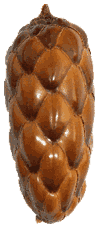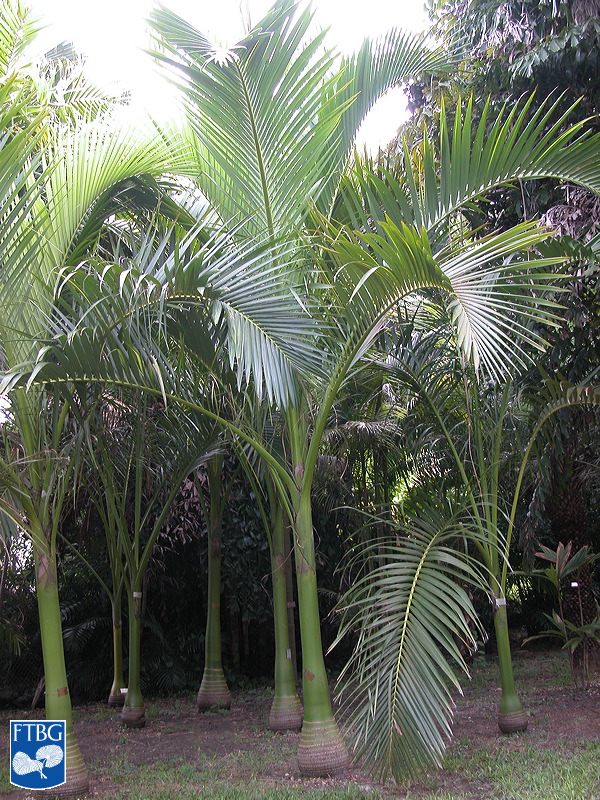 |
Palm |
 |
Palm |
This palm is native to the southernmost parts of the Vanuatu archipelago: the islands of Tanna, Futuna and Anatom. Natural stands are extremely rare; they are more commonly found planted near dwellings or small holdings.
A very tall palm sometimes exceeding 25 m in height. The base of the stem is thickened and bottle-shaped, but it tapers to 25 cm diameter at breast height. The recurved leaves are pinnate and up to 4 m long. The smooth, green crownshaft is particularly imposing in young plants. The flowers are borne on branched inflorescences, which emerge below the crownshaft. Fruits are obovate, approximately 7 cm long by 4 cm in diameter, red at maturity. The eccentric, subapical stigmatic scar of Carpoxylon macrospermum immediately distinguishes it from Veitchia species, which all have apical stigmatic scars. The generic name (carpo-, fruit; xylon, woody) refers to the thick, woody endocarp that encloses a single seed, which is notable for the pale streaks on the seed coat.
The genus Carpoxylon is montypic, meaning that it contains only one species. Capoxylon macrospermum has long been an enigma for palm botanists. It was known from the original publication made in 1875, which included illustrations of the fruit and seed. The locality was simply “New Hebrides” (the former name of Vanuatu), and even the original specimens were lost. Its evolutionary affinities and its place in the palm family were unknown until John Dowe serendipitously rediscovered the species in 1987 on the island of Espirtu Santo, Vanuatu. Only then were sufficient materials available for scientists to determine this species’ place in the palm family. The original specimen was subsequently found misfiled in the Natural History Museum (London) as a Veitchia species.
Information on the ecology of this species is limited to observations by Dowe of dubiously native palms growing in semi-natural situations in Vanuatu. No information is recorded regarding the pollination or fruit dispersal of this species.
Carpoxylon macrospermum is primarily used as ornamental palms in parks and gardens; however, there are several uses recorded from Vanuatu. The stem can be used as a building material and the enlarged base can be prepared as feed for domestic pigs. The leaflets can be used as a traditional roofing material in the same way as the coconut palm (Cocos nucifera). The roots are used in the preparation of numerous remedies. The immature (green) fruit are edible and are often eaten by local inhabitants.
The principal threat to this palm is the deterioration of its habitat by human activities. Deforestation for agriculture and possible loss of the seed dispersal agent(s) contribute to this palm’s uncertain future.
There are currently no specific conservation areas for this species, but like all other native Arecaceae, it is protected by law in Vanuatu. The Vanuatu Environment Unit has classed Carpoxylon macrospermum as high priority in terms of conservation.
Carpoxylon macrospermum is often cultivated in rural areas for its ornamental qualities, we have found examples of cultivated specimens on several islands, including Espiritu Santo, Mallicolo, Paama, Efate, Tanna and Anatom. These cultivated individuals likely represent significant reserves of genetic diversity and are informal ex situ conservation collections. Cultivated palms were identified as valuable seed sources for a “Profitable Environmental Protection” project set up by the Foundation for the Peoples of the South Pacific and funded in part by US AID. The project sought to use seeds from cultivated palms to satisfy the international horticultural demand for Carpoxylon. In this way, the natural stands of C. macrospermum would not be harmed. This project, however, seems no longer to be in operation and is no longer listed on the organization’s website (www.fspi.org.fj).
Carpoxylon macrospermum is sparingly cultivated outside its country of origin. It is, however, both highly ornamental and easy to grow and therefore has great potential in horticulture. The unavailability of seeds currently limits its use; however, as cultivated plants outside of Vanuatu become reproductive, seeds from cultivated sources can enter the trade.
Because it is amenable to cultivation, Carpoxylon macrospermum should be considered for ex situ conservation in botanical gardens worldwide. It is not know whether cultivated plants currently in botanical gardens adequately capture the genetic diversity remaining in Vanuatu. Additional genetic studies are indicated.
Increased protection for wild populations of this palm in Vanuatu are urgently needed.
 |
| Young plants of Carpoxylon macrospermum in cultivation at Fairchild Tropical Botanic Garden, Miami, Florida, USA. Photo by Julissa Roncal. |
Mr. Jean‑Michel Dupuyoo, Jardin d'Oiseaux Tropicaux, Conservatoire Biologique Tropical, 83250 La Londe, France
Dr. Scott Zona, Center for Tropical Plant Conservation, Fairchild Tropical Botanic Garden, 11935 Old Cutler Road, Miami, Florida 33156 USA
Dowe, J.L. 1989.
The unexpected rediscovery of Carpoxylon macrospermum.
Principes33: 63–67.
Dowe, J.L. 1996.
Uses of some indigenous Vanuatu palms.
Principes 40: 93-102.
Dowe, J.L. & P. Cabalion. 1996.
A taxonomic account of Arecaceae in Vanuatu, with descriptions of three new species.
Australian Systematic Botany 9:1-60.
Fry, K., S. Siwatibau & C. Clarkin 1997.
Conservation of a rare palm species through enterprise developments, pp. 87–95.
Sixth South Pacific Conference on Nature Conservation and Protected Areas, Volume 3.
Conference Papers. Sue Miller & Joanna Sim (eds.)
South Pacific Regional Environment Programme, Apia, Samoa.